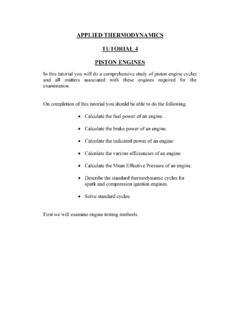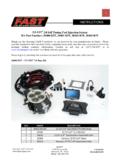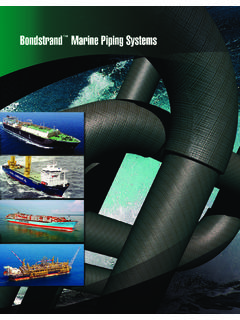Transcription of UNIT 61: ENGINEERING THERMODYNAMICS
1 1 unit 61: ENGINEERING THERMODYNAMICS unit code: D/601/1410 QCF level: 5 Credit value: 15 OUTCOME 2 INTERNAL COMBUSTION ENGINE PERFORMANCE TUTORIAL No. 5 PERFORMANCE CHARACTERISTICS 2 Be able to evaluate the performance of internal combustion engines Second law of THERMODYNAMICS : statement of law; schematic representation of a heat engine to show heat and work flow Heat engine cycles: Carnot cycle; Otto cycle; Diesel cycle; dual combustion cycle; Joule cycle; property diagrams; Carnot efficiency; air-standard efficiency Performance characteristics: engine trials; indicated and brake mean effective pressure; indicated and brake power; indicated and brake thermal efficiency; mechanical efficiency; relative efficiency; specific fuel consumption; heat balance Improvements: turbocharging; turbocharging and intercooling.
2 Cooling system and exhaust gas heat recovery systems On completion of this tutorial you should be able to do the following. Calculate the fuel power of an engine. Calculate the brake power of an engine. Calculate the indicated power of an engine. Calculate the Mean Effective Pressure of an engine. Calculate the various efficiencies of an engine. Examine how the performance of real engines may be improved. Explain the purpose f a turbo charger. Explain the purpose of a supercharger Explain the advantages of inter-cooling. Discuss the advantages of using waste heat recovery. Discuss the use of waster heat boilers. Discuss combined heating and power systems. 2 1 FUEL POWER ( ) Fuel power is the thermal power released by burning fuel inside the engine.
3 = mass of fuel burned per second x calorific value of the fuel. = mf x All engines burn fuel to produce heat that is then partially converted into mechanical power. The chemistry of combustion is not dealt with here. The things you need to learn at this stage follow. AIR FUEL RATIO This is the ratio of the mass of air used to the mass of fuel burned. Air Fuel Ratio = ma/mf The ideal value that just completely burns all the fuel is called the STOICHIOMETRIC RATIO. In reality, the air needed to ensure complete combustion is greater than the ideal ratio. This depends on how efficient the engine is at getting all the oxygen to meet the combustible elements.
4 The volume of air drawn into the engine is theoretically equal to the capacity of the engine (the swept volumes of the cylinders). The mass contained in this volume depends upon the pressure and temperature of the air. The pressure in particular depends upon the nature of any restrictions placed in the inlet flow path. CALORIFIC VALUE This is the heat released by burning 1 kg of fuel. There is a higher and lower value for fuels containing hydrogen. The lower value is normally used because water vapour formed during combustion passes out of the system and takes with it the latent energy. WORKED EXAMPLE An engine consumes kg/s of air. The air fuel ratio is 12/1. The calorific value is 46 MJ/kg. Calculate the Fuel Power.
5 SOLUTION Air consumed ma= kg/s. Mass of fuel mf = = kg/s Heat released calorific value x mf = 46 000 kJ/kg x kg/s KW 3 SELF ASSESSMENT EXERCISE 1. An engine consumes g/s of air with an air/fuel ratio of 13/1. The calorific value is 45 MJ/kg. Calculate the heat released by combustion. (149 kW) 2. An engine requires 120 kW of fuel power by burning fuel with a calorific value of 37 MJ/kg. The air fuel/ratio required is 14/1. Calculate the mass flow rate of air required. ( g/s) 4 2 BRAKE POWER ( ) Brake power is the output power of an engine measured by developing the power into a brake dynamometer on the output shaft. Dynamometers measure the speed and the Torque of the shaft.
6 The Brake Power is calculated with the formula = 2 NT where N is the shaft speed in rev/s T is the torque in N m You may need to know how to work out the torque for different types of dynamometers. In all cases the torque is T = net brake force x radius The two main types are shown below. Figure 1 Figure 2 Figure 1 shows a hydraulic dynamometer which absorbs the engine power with an impeller inside a water filled casing. Basically it is a pump with a restricted flow. The power heats up the water and produces a torque on the casing. The casing is restrained by a weight pulling down and a compression spring balance pushing down also. The torque is then (F + W) x R. Figure 2 shows a friction drum on which a belt rubs and absorbs the power by heating up the drum which is usually water cooled.
7 The belt is restrained by a spring balance and one weight. the second equal weight acts to cancel out the other so the torque is given by T = F R. 5 3 INDICATED POWER This is the power developed by the pressure of the gas acting on the pistons. It is found by recording the pressure against volume inside the piston. Such diagrams are called indicator diagrams and they are taken with engine indicators. The diagram shows a typical indicator diagram for an internal combustion engine. Figure 3 The average force on the piston throughout one cycle is F where F = MEP x Area of piston = pA The Mean Effective Pressure p is the mean pressure during the cycle. The work done during one cycle is W = F L = pAL L is the stroke.
8 The number of cycles per second is N. The Indicated Power is then = pLAN per cylinder. Note for a 4 stroke engine N = the shaft speed. 6 The mean effective pressure is found from the indicator diagram as follows. The area enclosed by the indicator diagram represents the work done per cycle per cylinder. Let this area be Ad mm2. The average height of the graph is H mm. The length of the diagram is Y mm. The hatched area is equal to Ad and so Ad = YH H =Ad/Y In order to convert H into pressure units, the pressure scale (or spring rate) of the indicator measuring system must be known. Let this be Sp kPa/mm. The MEP is then found from MEP = Sp H This is also known as the Indicated Mean Effective Pressure because it is used to calculate the Indicated Power.
9 There is also a Brake Mean Effective Pressure (BMEP) which is the mean pressure which would produce the brake power. BP = (BMEP) LAN The BMEP may be defined from this as BMEP = BP/LAN 4 EFFICIENCIES BRAKE THERMAL EFFICIENCY This tells us how much of the fuel power is converted into brake power. BTh = INDICATED THERMAL EFFICIENCY This tells us how much of the fuel power is converted into brake power. ITh = MECHANICAL EFFICIENCY This tells us how much of the indicated power is converted into brake power. The difference between them is due to frictional losses between the moving parts and the energy taken to run the auxiliary equipment such as the fuel pump, water pump, oil pump and alternator.
10 Mech = 7 WORKED EXAMPLE A 4 cylinder, 4 stroke engine gave the following results on a test bed. Shaft Speed N = 2 500 rev/min Torque arm R = m Net Brake Load F = 200 N Fuel consumption mf = 2 g/s Calorific value 42 MJ/kg Area of indicator diagram Ad = 300 mm2 Pressure scale Sp = 80 kPa/mm Stroke L = 100 mm Bore D = 100 mm Base length of diagram Y = 60 mm. Calculate the , , , MEP, BTh, ITh,and mech, SOLUTION BP = 2 NT = 2 x (2500/60)x (200 x ) = kW FP = mass/s x = kg/s x 42 000 kJ/kg = 84 kW IP = pLAN p = MEP = Ad/Y x Sp = (300/60) x 80 = 400 kPa IP = 400 x x ( x ) x (2500/60)/2 per cylinder IP = kW per cylinder. For 4 cylinders IP = x 4 = kW BTh= = ITh= = % mech= = 80% 8 SELF ASSESSMENT EXERCISE 1.













